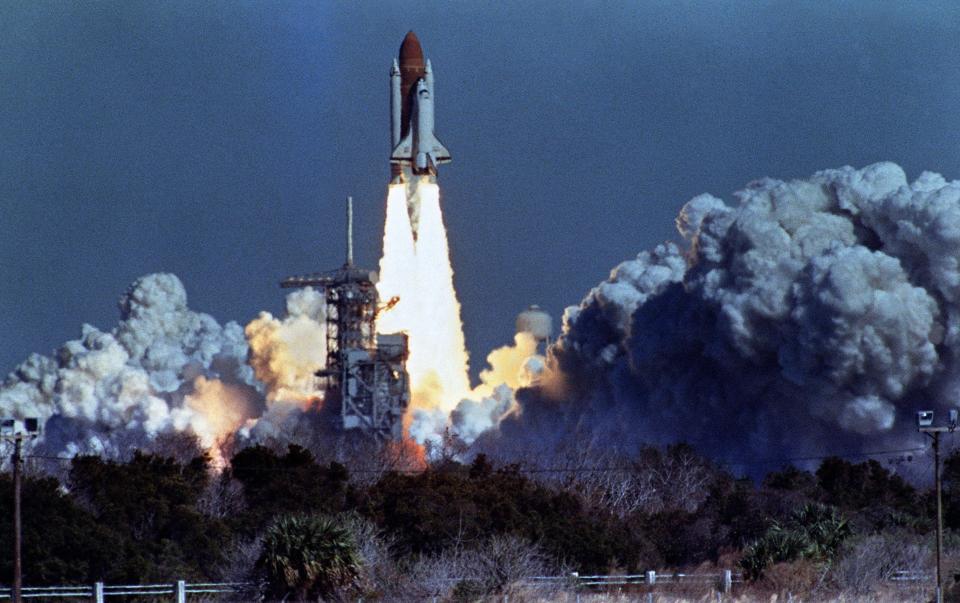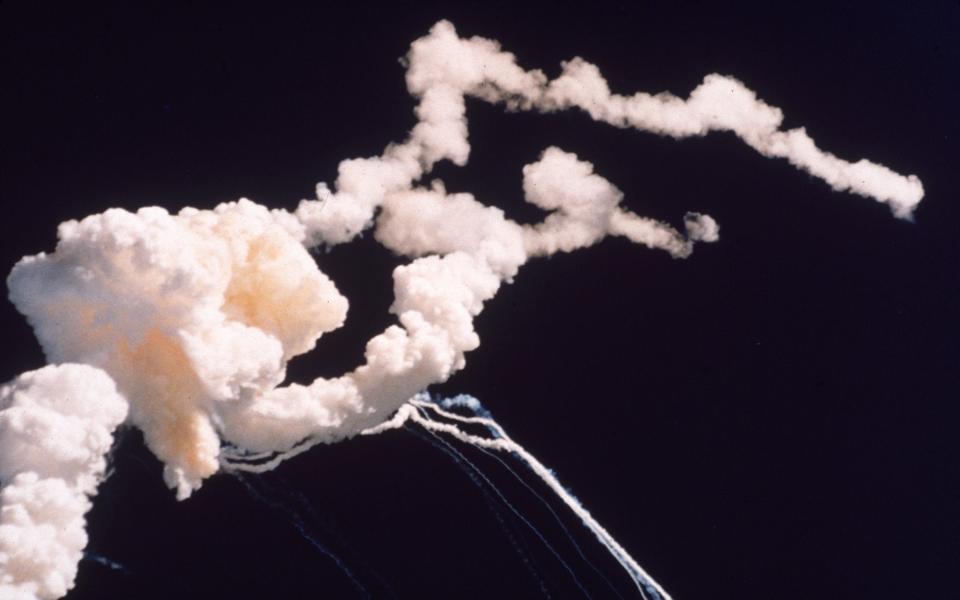The chaotic days before the Challenger disaster – and the awful aftermath

- Oops!Something went wrong.Please try again later.
- Oops!Something went wrong.Please try again later.
In the dying days of the Second World War, one of Hitler’s most brilliant rocket scientists put forward an ambitious plan to strike at America. Eugen Sänger’s design, dubbed the Silbervogel or “Silver Bird”, was part rocket, part spacecraft. Shaped like a squashed paper plane, it would blast off from Germany and into low-earth orbit; from there, it would use its flattened shape to “skip” along the denser gases of the inner atmosphere, then bomb New York, before continuing to Japan to refuel, spinning around and attacking Los Angeles on its way back to Berlin – thus strafing the entire American continent.
The Silbervogel never moved beyond the graph-paper stage. Yet Sänger’s outlandish ambition for a reusable space plane, and his design – an ungainly, snub-nosed craft designed to slow itself through friction on its return to earth – would ultimately form the basis of America’s Space Shuttle programme. In the 1960s and 1970s, the elegant, spindle-like Apollo rockets had taken 12 men to the surface of the Moon; by contrast, the Shuttle was expected to blast off almost weekly, hauling commercial and military payloads into space and taking journalists and dignitaries on jollies. It was, Adam Higginbotham writes, “the most complicated machine in history” – and, flight for flight, it would become one of the most lethal.
Higginbotham’s superb Challenger tells the full, tragic arc of the Space Shuttle programme. Using the same combination of archival research and interviews that characterised his first book, Midnight in Chernobyl (2019), it is authoritative and immediate – scrupulous history which has the ripping compulsion of the best reporting.
The heart of Higginbotham’s story is the disaster of January 28 1986. One minute and 15 seconds after it launched from Cape Canaveral, in Florida, Challenger, one of the programme’s five operational craft, disappeared in a gigantic fireball. It was carrying seven men and women on board. Witnesses, watching in person and in front of screens across the world, saw a small streak of smoke lick one of the rocket boosters; an instant later, the entire craft was engulfed in flames. Challenger itself seemed to vanish, its crew swallowed in the vast blue dome of the sky. Millions were watching on live television. Just over six hours later, the US president, Ronald Reagan, addressed his nation from the Oval Office. It’s estimated that by the end of that day, 95 per cent of Americans had seen the footage. The Challenger disaster became a public tragedy matched only by the assassination of JFK – and, less than two decades on, 9/11.
Higginbotham forensically unpicks the cavalcade of cost-cutting and back-covering that preceded Challenger’s destruction. Yet I found his earlier chapters, contextualising the Space Shuttle programme, equally engrossing. He reminds us that the Space Race was never universally popular: many in the US government and wider public considered it costly, wasteful and, above all, pointless. In addition, its unassailable iconography – William Anders’s “Earthrise” photograph of 1968, Neil Armstrong’s first steps on the Moon in 1969 – failed to convince everyone that it was representative of an increasingly diverse America. Such attitudes were captured by African-American writer Gil Scott-Heron’s poem ‘Whitey on the Moon’: “Was all that money I made last year (for Whitey on the moon?) / How come there ain’t no money here? (Hmm! Whitey’s on the moon.)” Some made their feelings plain in a simpler fashion. A month after Armstrong and his crew returned from space, they were feted at a Hollywood gala attended by then-president Richard Nixon. Protestors hung a banner on a building opposite. It read simply: “F--- MARS.”

As a result of this criticism, Nasa resolved that the Space Shuttle programme would have more diverse crews. Aboard the Challenger, that morning in 1986, were Ron McNair, a polymathic astronaut who was the second black man in space, and the first musician to record in orbit (with a saxophone solo for a Jean-Michel Jarre album). The Shuttle also had two female crew: Judy Resnik, a no-nonsense engineer who’d fought for years for the right to fly, and Christa McAuliffe, a social-studies teacher. McAuliffe had been chosen from more than 11,000 participants as part of Nasa’s Teacher in Space programme, an initiative to open space-travel up to civilians. During her time in orbit, she was to give lessons to America’s children via video link. Among those watching Challenger’s launch from Cape Canaveral were 350 pupils from McAuliffe’s school in New Hampshire, flown down to Florida for the occasion.
Higginbotham explains that there remains little mystery behind Challenger’s destruction. From the beginning, the loaded guns are the O-rings, rubber seals inside the rocket boosters designed to prevent the highly explosive gases inside them from mixing. Built by contractor Morton Thiokol, experts warned repeatedly that the O-rings in boosters recovered from previous flights contained worrying signs of erosion. The problem became worse in lower temperatures, and in extreme cold, the rings would sometimes fail to seal entirely. Temperatures on the pad on the morning of January 28 were the lowest ever recorded before a launch. Roger Boisjoy, a Thiokol engineer, argued – until the night before Challenger’s launch – that it should be grounded. Fearful of losing their contract, and conscious of Nasa’s breakneck timetable, senior managers overruled him.

The Challenger disaster didn’t stop the Space Shuttle programme. It resumed 32 months later, when Discovery successfully launched in September 1988, and even though Columbia and her seven crew were also lost in 2003, the Shuttle disintegrating on its return to Earth’s atmosphere after the thermal-protection system failed, the flights continued until 2011. But January 1986 was when the dream of routine government-backed space flight began to die, crushed by hubris, incompetence and too many bureaucratic cock-ups.
In the end, though, the power of Higginbotham’s book lies in his focus not just on that body-blow to America’s self-confidence, but on the human toll it took. The families of the crew were relentlessly dogged as, day by day, they were forced to relive the most harrowing moments of their lives. When Alison Smith went to the mall to buy an outfit for a memorial, a wake of silence followed her as strangers hushed in her presence. And weeks after the disaster, June Scobee, wife of the Shuttle’s late commander Dick, would find herself collapsing when out shopping: she would put her husband’s favourite peanut-butter in the trolley, only to realise there was no one home to eat it.
And in a grim twist, crash investigators determined in the summer of 1986 that – contrary to what had initially been assumed – the crew module did not immediately blow apart. It’s highly likely that the crew were still alive during their two-and-a-half minute freefall to the Atlantic, 18 miles off the coast. An examination of the craft’s instrument panel determined that, as he fell, pilot Mike Smith had been frantically trying every procedure he could think of. “He knew he was going to die,” writes Higginbotham. “But he never stopped trying to live.”
Challenger is published by Viking at £25. To order your copy for £19.99, call 0808 196 6794 or visit Telegraph Books

